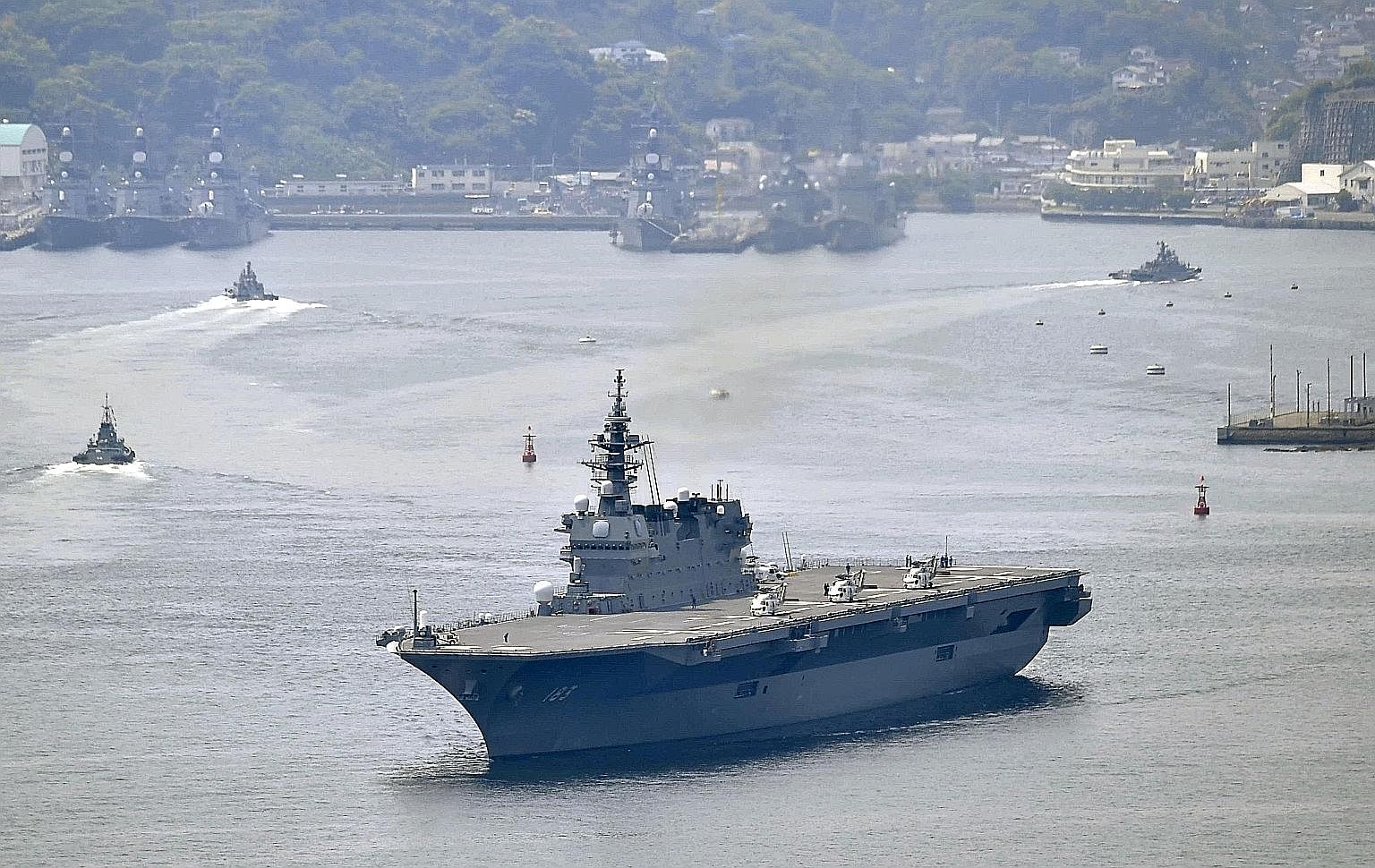When Japan's largest warship, the Izumo, left its home port on May 1 for distant seas, her departure was described by some reports as a show of force.
The warship and the destroyer assigned to escort her, carrying some 700 sailors in total, arrived at Changi Naval Base last Friday. Singapore is the first port call on her 100-day journey, which is the largest deployment of Japanese naval power to the region since World War II.
Analysts have been abuzz over the intended audience for this demonstration of naval power. The timing of the deployment also fuelled speculation as maritime security in the Sea of Japan/East Sea and the debate over freedom of navigation in the South China Sea have been hot topics recently.
Some thought the deployment was directed at the North Koreans. There were reports on Izumo's role in escorting an American naval supply ship and speculation she might team up with the United States Navy aircraft carrier, USS Carl Vinson, but the Izumo is long past the Korean peninsula.
As she ventured south, others thought the Izumo's journey through the South China Sea was meant to send a signal to China.
At 248m long (almost five Olympic-length swimming pools) and displacing 27,000 tonnes when fully loaded, the Izumo is more than just a big ship.

With a flight deck and an island superstructure offset to the right side of the warship, Izumo has the form and function one would expect from an aircraft carrier. This class of warship is operated by a handful of Asian navies - Australia, China, India and Thailand - and is viewed as a symbol of naval power, prestige and influence.
The Japanese are keenly aware of the signature Izumo could inadvertently project and the brochure on the ship is devoid of any suggestion it is an aircraft carrier. Izumo is described officially as the Japan Maritime Self-Defence Force's (JMSDF) - itself a navy in all but name - "largest and most sophisticated destroyer".
In his first interview since arriving in Singapore, the JMSDF admiral leading the Izumo and her escorting destroyer, the Sazanami, downplayed speculation over her deployment.
Rear-Admiral Yoshihiro Goka, commander of Escort Flotilla One, outlined three reasons for the deployment.
First, the Izumo's visit to Asean countries is meaningful from a Japanese perspective and timed with the 50th anniversary of the regional grouping, which was formed in August 1967. Describing her deployment as a "great honour and opportunity" to reach out to friends in the region in this milestone year, the admiral said Asean members are among Japan's closest trading partners.
"The Asean people are a great partner for Japan. We provide great support for each other," the admiral said.
Second, RADM Goka's 25-year career at sea has impressed upon him that "the ocean should be free for everyone to use". Choosing his words carefully and without naming any maritime state, the admiral described the seas as a "public area". Hence, he contends that "everybody has the right to use the public area".
He noted that maritime links are vital to Japan as about a third of the world's trade transits regional sea lanes. Furthermore, almost all the oil and gas that Japan imports is delivered by tankers which use the region's maritime highways. "This is a very important area where mutual support is needed," he added.
The Izumo's role in naval diplomacy ties in with her port visit here.
Today, the Republic of Singapore Navy (RSN) will stage the International Maritime Review as part of celebrations commemorating its 50th year. The JMSDF warships are among 30 warships from 20 countries taking part in Singapore's first maritime review at Changi Naval Base. Interactions with officers and men from different countries will allow the JMSDF to share more about its role even as the Japanese learn about foreign naval forces.
The third reason underlines the pragmatic nature of the Japanese. Being far from home takes the 700 JMSDF personnel aboard Izumo and Sazanami out of their comfort zone. Sending the Izumo away for about 100 days, with air and naval operations taking place in unfamiliar sea lanes, exposes the crew to fresh challenges and is a valuable training opportunity.
"When we train around Japan, it is easy to get support," said RADM Goka. "However, deploying for a long time and long distance overseas will allow us to test how to train our people and maintain the equipment. That is a challenge."
So there you have it: The deployment is calibrated to demonstrate Japan's support for the 50th anniversary of Asean and will also test the mettle of sailors and airmen as Izumo embarks on her farthest and longest voyage from Japan.
With more than two months to go before Izumo returns home, its journey to regional destinations, all the way to the Indian Ocean, is likely to be closely tracked by analysts.
All will be eager to see if the Izumo was sent by Tokyo to project its hand of friendship, or whether it is indeed a show of naval power projection.
• The writer, a former defence correspondent with The Straits Times, is a member of the Advisory Council on Community Relations in Defence.
• This article first appeared on his blog kementah.blogspot.sg
